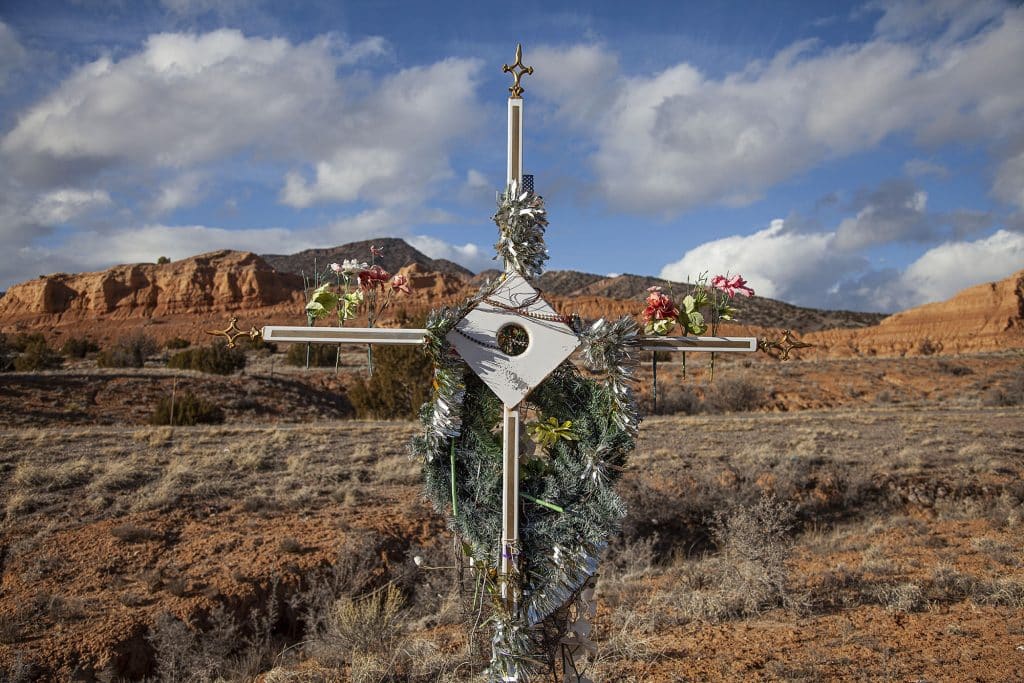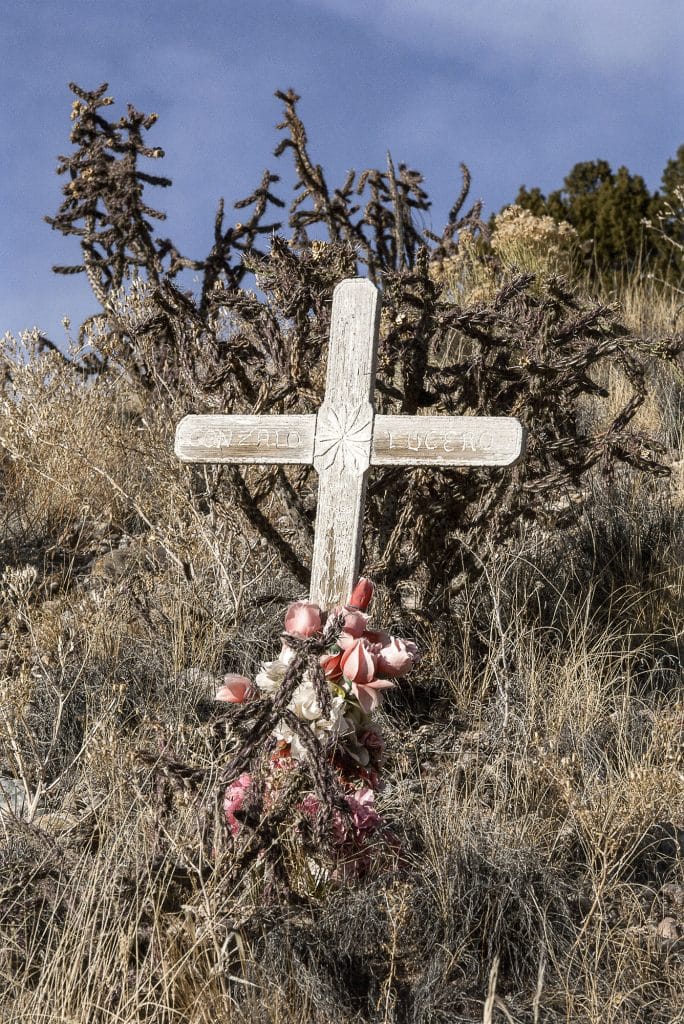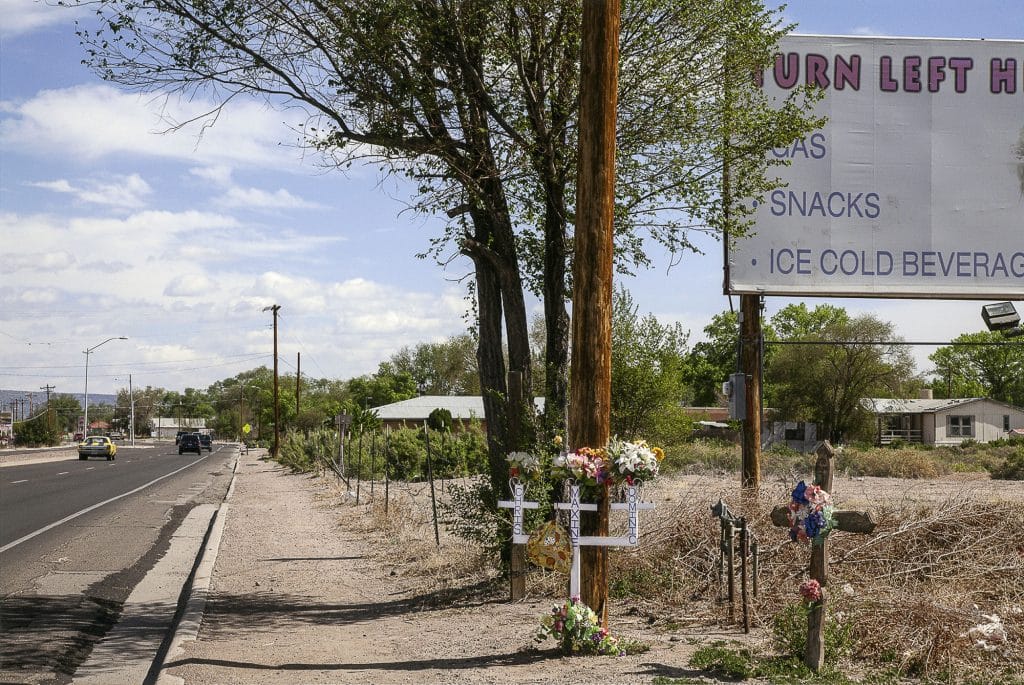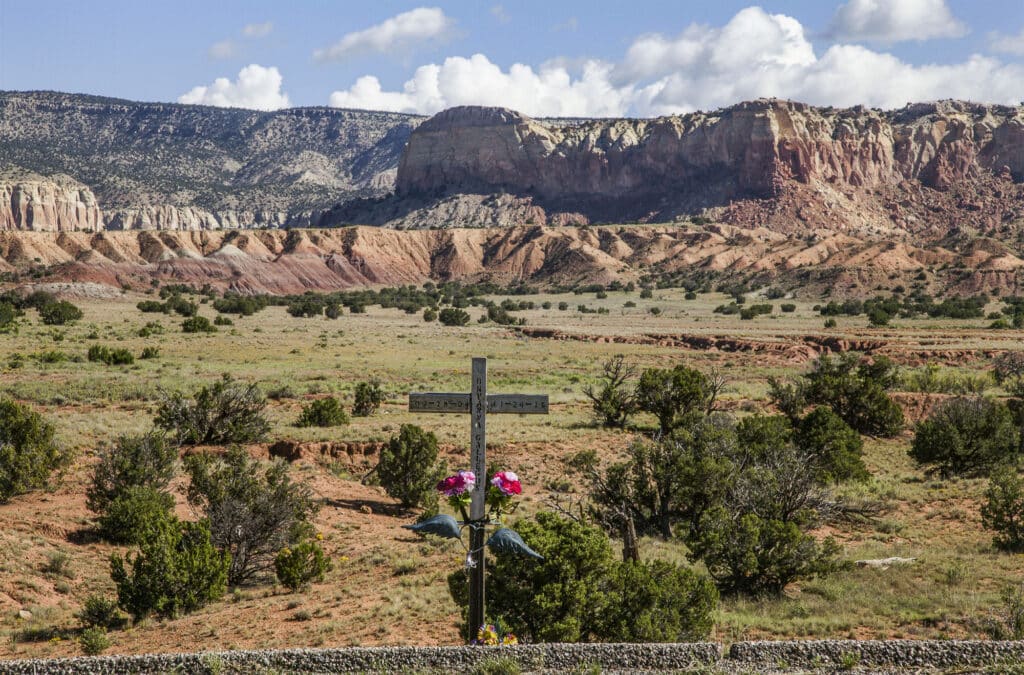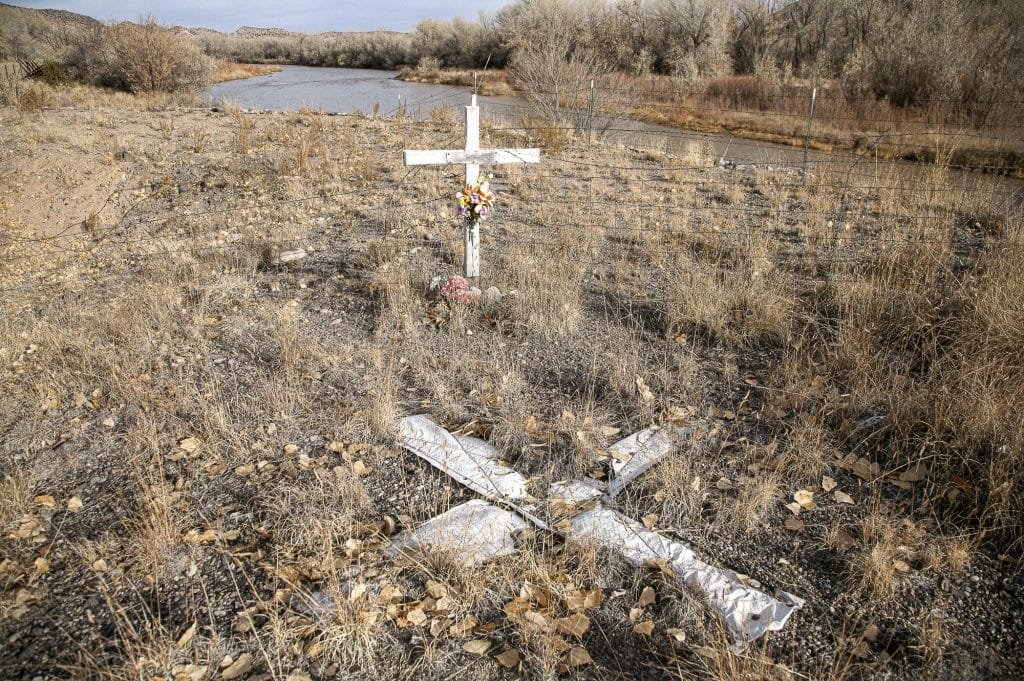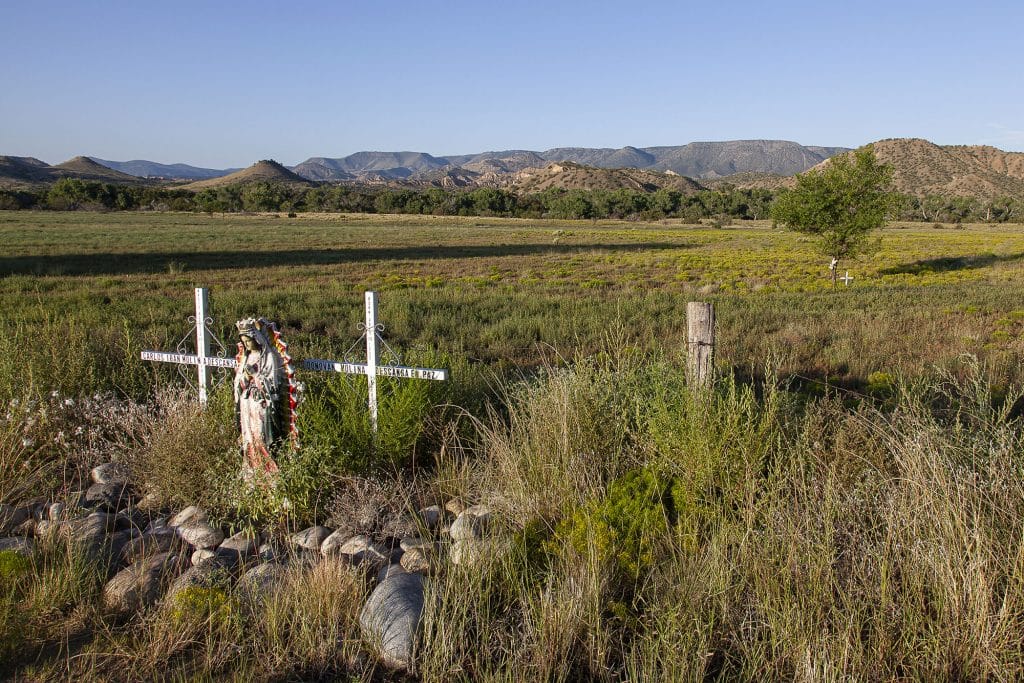Not long ago, while zipping down a beautifully desolate stretch of New Mexico highway — with the light that once tugged at Georgia O’Keeffe glowing pink in my rearview mirror — I zoomed by a tall, tilting wooden cross planted on the road’s dusty shoulder. It was draped in a blur of blue plastic flowers surrounded by what looked a ring of bottles, and it was gone before I had much of a chance to take it in. But I was instantly aware of one thing: A person had died there. Right there. Someone had been on the road, just as I was, when everything suddenly stopped.
For a split second, I took my foot off the gas: I should pull over and take the photo, I told myself. But I was late for dinner and an SUV was coming up fast behind me. So I drove on. If there’s a German word for “feeling regret for not taking a picture,” I could have used it.
Unlike me, artist and photographer Judith Hidden Lanius would have stopped and made the photo. In fact, over the course of a decade, she traced thousands of miles of New Mexico’s roads and took pictures of these handmade memorials as she came upon them. She’s collected 50 of her images in a tightly focused, quietly stirring new book, Mortal Highway (Daylight Books). Lanius shot these markers — some bare-bones wooden crosses, others elaborately wrapped with personal ephemera like reflective sunglasses and bullet shells — with an equal reverence for the lonely memorials and the sweeping high-desert landscape in which they sit. The result is something elegiac and beautiful.
Where Beauty Meets Violence
The roadside memorials — called descansos, or “resting places,” by the Hispanic families who create them — are typically placed at the site of a violent and unexpected death. And if you care to imagine the moment, it probably came with the howling of brakes, the splintering of glass, and the sharp punch of metal meeting metal. But Lanius’s pictures of the descansos are as quiet as clouds, and shot in such a way that they seem at odds with the very reason that they’re there. “There’s a tension between living in this very beautiful place,” she says, and also living with these violent deaths. “The descansos speak to that tension.” As do her pictures: They whisper that life is short and unpredictable, that we might be fiddling with the volume knob or glancing at glorious sunset one minute, and slamming on the brakes the next.
Lanius, a largely self-taught photographer, has focused her gaze on the desert before (a previous project took her to a remote Moroccan town on the edge of the Sahara), and while she shoots the descansos in all seasons, the weathering power of the desert sun is ever-present here. Some of her pictures depict the crosses in such detail that you can see cracks in the time-worn wood and the fraying of sun-bleached fabric flowers. Other frames embed the descansos deep in the landscape where they blend in so seamlessly that it takes a moment for them to reveal themselves in the trees or desert scrub. The effect is haunting, as if to remind us of all the people whose lives we never notice, even as we pass within inches. Sometimes, they seem to say, a life is small and hard to see.
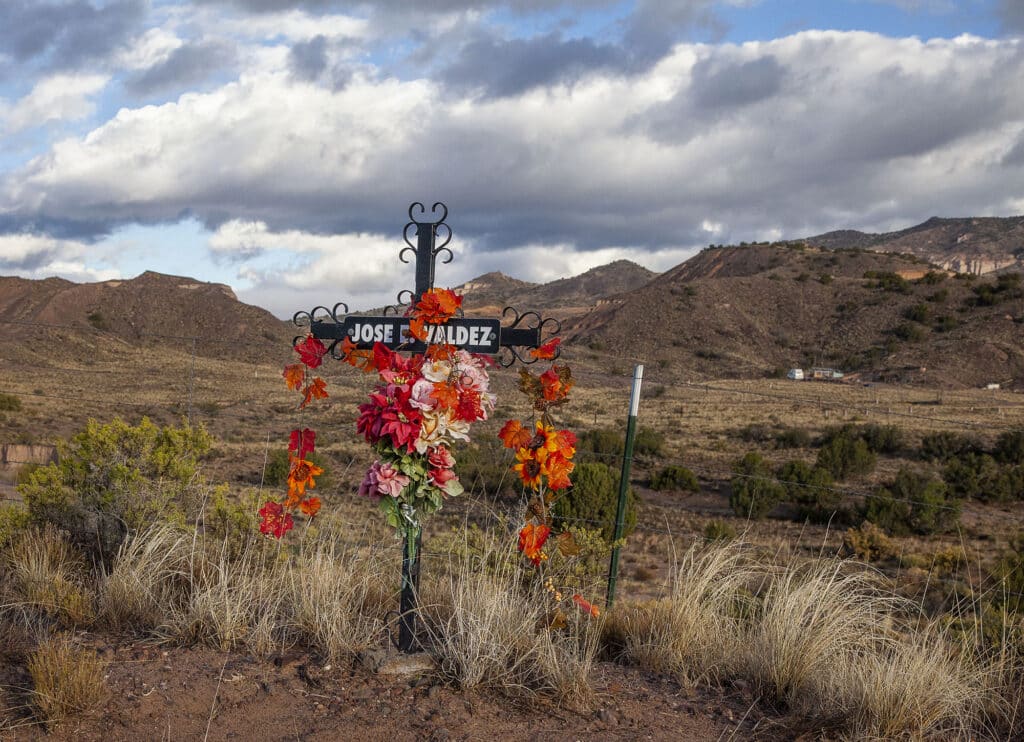
A Memorial, A Warning
You will not find people in Lanius’s pictures and there’s a poetic reason for this: “I think of these as final portraits,” she says, and the presence of family members would distract from that mission. But there’s something else, too. Unlike a formal cemetery headstone, the descansos “are not a place to visit, not a place to stop. It’s rare to see people there,” she explains. That’s because you stand on the side of a New Mexico road at your peril. In fact, one of the reasons families plant the crosses is as a sort of public service warning to drivers: If you see a colorful descanso up ahead, where the road begins to bend, you might be moved to proceed with a bit more humility.
But while Lanius left the families out of her frames, she did something that not enough photographers take the time to do: gutsy, shoe-leather reporting. She approached about a dozen families and interviewed them about the relative they lost and the memorial they built. Many of the photos are accompanied by spare, devastating lines like this:
“His parents never knew what happened. They waited for him all day, thinking he was in the mountains cutting firewood.”
“The two women were stopped at a busy intersection in Espanola when logs from a timber truck rolled onto their car.”
In so doing, Lanius gives the markers just enough backstory to satisfy the question that inevitably rises within us as we look at her pictures: What happened here? She also includes a map showing where every descanso in the book is located as well as a bit of background on the place of the roadside memorials in Hispanic history and culture.
Given Lanius’ background, this kind of contextualization makes sense. Before moving to “a mountaintop north of Santa Fe,” Lanius lived in Washington, DC, where she worked in the art history establishment, including a stint at National Building Museum and then as the chief curator and preservation officer of the US Treasury Building. While a more sophisticated design could have given the book added emotional punch, but Mortal Highway offers us intriguing layers. And like a long, silent meditation, its images lead us to think about exactly what photos are meant to make us think about: the nature of memory, the things we leave behind, and, sometimes, the very nature of life itself.
Mortal Highway, Judith Hidden Lanius, is published by Daylight Books, 128 pages, $45.
